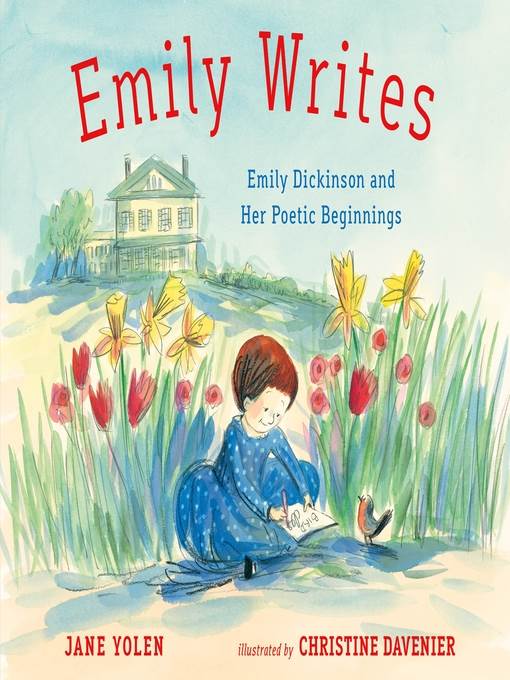
Emily Writes
Emily Dickinson and Her Poetic Beginnings
کتاب های مرتبط
- اطلاعات
- نقد و بررسی
- دیدگاه کاربران
نقد و بررسی

January 6, 2020
Yolen and Davenier portray Dickinson as a small child who “tiptoes into Father’s study,/ being quiet as dust” and finds “a scrap of paper” and a “gnawed pencil stub, too... Perhaps, she thinks, I will make a poem.” Historical details—her siblings, Lavinia and Austin; her mother’s illness (“Mother,/ who makes her feel rainy”); her father’s emotional distance—add ballast to the imagined account. Most delightful is Mrs. Mack, of the family that bought the Dickinson family house and lived in it while the Dickinsons rented rooms. Yolen’s Mrs. Mack encourages Emily: “Hope, my dear girl,/ That’s the best rhyme for envelope. Though in a pinch you might try cope or lope.” Though an author’s note suggests that not much is actually known of Dickinson’s childhood, nor of her relationship with Mrs. Mack, Yolen conjures appealing possibilities. Davenier’s loose-lined, color-washed ink illustrations capture childlike joy and curiosity. Ages 4–8.

February 1, 2020
Gr 1-6-Incorporating bits from Emily Dickinson's poetry and what is known of her adult life, Yolen imagines an afternoon with four-year-old Emily. Slipping into her father's study, young Emily "discovers a scrap of paper under father's desk, some chance slip." (Adult Emily refers to her odds and ends of used writing paper as "chance slips.") This is a cheerful, deeply thoughtful child. "Perhaps, she thinks, I will make a poem." And so she does. Emily tries to tell her rhyming three-word bit-"frog and bog"-to her inattentive father and then her fretful mother, and finally succeeds down in the kitchen with friendly Mrs. Mack. (Readers learn more about Mrs. Mack in the author's note.) Once these two share laughter and a bit of cake, Emily goes out to the garden where her story becomes more complex and romanticized: "...she has not told her poem to the flowers yet...the garden makes her feel all sunny, like a poet...She thinks about the real and the unreal. Perhaps poems are the in-between." Emily goes on to find an envelope and consults Mrs. Mack about a word to rhyme with envelope. Yolen's cleverly constructed scheme will intrigue adult Dickinson fans. French illustrator Davenier's multimedia sketches provide simple, deft views of characters and settings. Yolen's substantial author's note tells much about Emily Dickinson and excerpts poems. A bibliography of adult and scholarly sources includes a few titles accessible to children. VERDICT Some parents might share this with children learning to read and write. It could also spark good discussion with older students studying Dickinson in poetry units.-Margaret Bush, Simmons College, Boston
Copyright 2020 School Library Journal, LLC Used with permission.

January 1, 2020
The imagined events of one day in the early life of Emily Dickinson foreshadow her future creations. Yolen sets the stage with an opening caption announcing it's "spring 1834, Amherst, Massachusetts." Young Emily, a smiling, round-headed child, takes scraps of paper from beneath her father's desk, scribbles on them, and tries to share the results. Largely ignored by her father, she finds Mrs. Mack, a friendly woman busy in the kitchen, to be more receptive. Mrs. Mack listens to Emily's poem "Frog and bog!" and pronounces it "A very good rhyme indeed." After a trip upstairs to see her mother and baby sister, Emily ventures outside to share her words with the flowers and revel in the beauties of nature. Re-entering the house, Emily finds an envelope that prompts her to start thinking of rhymes again. Line breaks in most sentences and the way the text blocks are placed on the pages give the appearance of poetry. Although relatively lengthy, the text moves along smoothly with plenty of appealing turns of phrase and engaging images. Davenier's lively illustrations, created with watercolor ink, vary in size and placement. Lightly sketched settings and period details offer some context. The author's note fills in a few details while acknowledging that little is known about Dickinson's childhood. The appended poems relate to words and ideas that appear in the story. A warm portrait that even those unfamiliar with the iconic poet will likely enjoy. (bibliography) (Picture book. 6-8)
COPYRIGHT(2020) Kirkus Reviews, ALL RIGHTS RESERVED.

























دیدگاه کاربران